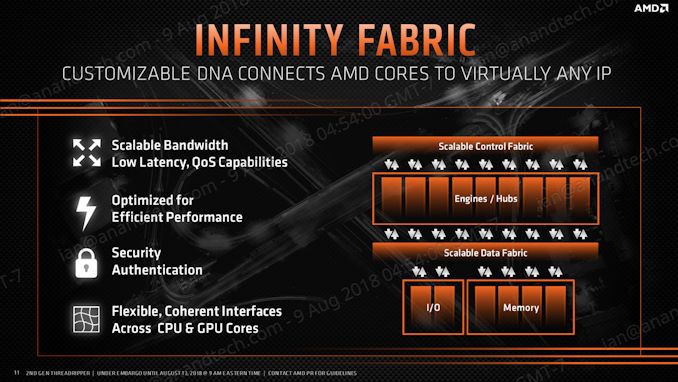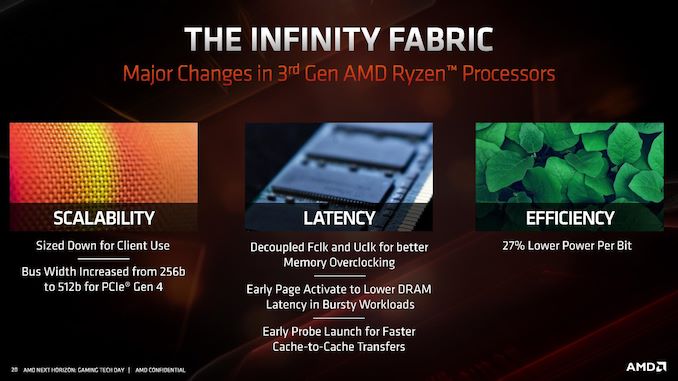The Corsair DDR4-5000 Vengeance LPX Review: Super-Binned, Super Exclusive
by Gavin Bonshor on January 27, 2020 9:00 AM ESTInfinity Fabric Overclocking: What the FCLK
With AMD’s 3rd generation Ryzen processors, AMD has increased the flexibility of the memory subsystem and added separate control for two elements dubbed FCLK and UCLK. These elements have technically always been present, but previously were always linked to memory speed. Before we proceed though, some definitions:
FCLK – Fabric ClocK. FCLK controls the speed of AMD’s Infinity Fabric, which handles communication across their CPUs. On 3rd generation Ryzen, Infinity Fabric and therefore FCLK or Fabric Clock has particular responsibility for the connections between the Core dies and the IO die. UCLK – Unified memory controller ClocK.
UCLK - This controls the speed of the memory controller itself.
MEMCLK – Memory clock on DDR4 memory is often referred to by the data rate, for example, this “5000 MT/s” kit is so called because at the advertised speed data is transferred 5000 million times per second. The physical clock signal that governs this data transfer, however, is 2500 MHz at the advertised speed – the data rate is double the physical clock, hence Double Data Rate. In AMD’s language this physical clock is called MEMCLK, and often shows up in bios settings under this name. MEMCLK is important because of how FCLK and UCLK relate to it.
Technically, all of these elements have always existed on all AMD’s Zen-based processors, back to 1st generation Ryzen and the enterprise equivalents, but FCLK and UCLK were always locked to MEMCLK making them effectively one and the same. What differs with 3rd generation Ryzen is that rather than being tied to MEMCLK, FCLK can now be set totally independently and UCLK has a choice of two ratios to MEMCLK – 1:1 and 1:2 (UCLK:MEMCLK).
Setting FCLK on Matisse
Although FCLK is now free to run at any speed, in practice there’s a performance bonus from running FCLK, UCLK and MEMCLK synchronized together. At lower MEMCLK speeds this may be outweighed by increasing – more specifically, overclocking – FCLK independently and when overclocking to very high MEMCLK it is simply no longer possible for FCLK to keep up and it must be run at a reduced speed.
By default FCLK, UCLK and MEMCLK are still synced together on 3rd generation Ryzen for speeds up to and including DDR4-3600 (1800 MHz FCLK/UCLK/MEMCLK), and as a result users with DDR4-3600 kits find these parameters well optimised without additional tweaking.
With this extremely high-speed DDR4-5000 kit, FCLK and UCLK cannot be synched with MEMCLK, and for the best possible performance, it’s advisable to manually overclock FCLK independently. On MSI motherboards as tested, the FCLK frequency and UCLK ratio (“UCLK DIV1 MODE”) are found in the “DRAM Setting” portion of the OC menu.
Test Bed
To test the performance of the Corsair Vengeance LPX DDR4-5000 memory kit, we tested the kit at three different frequencies with Infinity Fabric clocks in a ration of 2:1. Our maximum limit on the Infinity Fabric before we reached instability was 1800 MHz, which is a common limit for users. Some Ryzen 3000 processors can clock as high as 1900 MHz which would equal DDR4-3800, but AMD themselves say the sweet spot for memory performance on Ryzen 3000 and X570 is around DDR4-3600.
| Test Setup | |||
| Processor | AMD Ryzen 3700X, 65W, $329 8 Cores, 16 Threads, 3.6 GHz (4.4 GHz Turbo) |
||
| Motherboard | MSI MEG X570 Ace (BIOS 1.40 - ABBA) | ||
| Cooling | ID-Cooling Auraflow Pink 240mm AIO | ||
| Power Supply | Thermaltake Toughpower Grand 1200W Gold PSU | ||
| Memory | 2x8GB Corsair Vengeance Tested at: DDR4-3200 18-26-26-46 1T (FCLK 1600 MHz) DDR4-3600 18-26-26-46 1T (FCLK 1800 MHz) DDR4-5000 18-26-26-46 1T (FCLK 1800 MHz) |
||
| Video Card | ASRock RX 5700 XT Taichi X 8G OC+ (1810/2025 Boost) | ||
| Hard Drive | Crucial MX300 1TB | ||
| Case | Open Benchtable BC1.1 (Silver) | ||
| Operating System | Windows 10 1903 inc. Spectre/Meltdown Patches | ||












54 Comments
View All Comments
TheinsanegamerN - Tuesday, January 28, 2020 - link
While funny as a "what if" scenario, realistically nobody is going to pair a $150 APU with $1200 memory. AMD APUs likely couldnt push this stuff to 5000mhz anyway, hell most intel chips would struggle with 5000mhz.29a - Wednesday, January 29, 2020 - link
The only thing this memory would benefit is an APU, it would be nice just to see what it would do. Nobody is going to buy this memory for any reason other than bragging rights so they might as well had tested it with a APU.TomWomack - Monday, January 27, 2020 - link
Is there any way you could run Prime95 on this? It is spectacularly memory limited (on an i9-7940X for the largest FFT sizes it is barely 50% faster on 14 cores than on 4), so a best-case test.Alistair - Monday, January 27, 2020 - link
Seems like there is no point to this when buying a Threadripper and getting more memory channels gets you better results for less money.SanX - Monday, January 27, 2020 - link
Never seen on any website comparison of dual channel versus quad channel versus 6-channel versus 8-channel memory architectures. Instead all testers pump and pump and pump for years everyone know barely useful MHz because memory companies pay for the ad. You forgot 10% and even 20% difference in PC computing (and 2x in supercomputing) is essentially equal to ZERO difference?Take simple Gauss elimination Ax=B test from Intel XML library with AVX512 and compare different Intel processors, other tests and clear this question finally. May be even AMD processors which do not support ACX512 will shine here due to memory bandwidth.
eastcoast_pete - Monday, January 27, 2020 - link
Really puzzled by who would buy this outrageously expensive memory? The only use scenario I can imagine is in high-speed trading, where companies pay millions to be a few milliseconds ahead (for example, by getting their own fiber optic links to the CBE), but not sure if anyone in that field uses Ryzen systems.deneb - Tuesday, January 28, 2020 - link
This test would be great with threadrippers! Especially the 64 core.ManuelDiego - Tuesday, January 28, 2020 - link
Do these high speed RAM kits work at the advertised speeds when used with a Ryzen 3xxx series but on a B350 board? I know the memory controller is on the die, but i assume the traces on the board may also be a factor.Maxiking - Tuesday, January 28, 2020 - link
Could you please tell what sane person test impact of RAMS with AMDslow cpus and slow gpus? 5700xt? really?Did you outsource reviews to India?
catavalon21 - Tuesday, January 28, 2020 - link
Feel free to jump right in and write a better one.